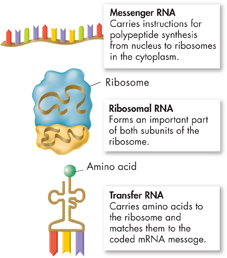VISUAL ANALOGY
MASTER PLANS AND BLUEPRINTS

FIGURE 13–1 The different roles of DNA and RNA molecules in directing protein synthesis can be compared to the two types of plans used by builders: master plans and blueprints.
Similarly, the cell uses the vital DNA “master plan” to prepare RNA “blueprints.” The DNA molecule stays safely in the cell's nucleus, while RNA molecules go to the protein-building sites in the cytoplasm—the ribosomes.
Functions of RNA You can think of an RNA molecule as a disposable copy of a segment of DNA, a working facsimile of a single gene. RNA has many functions, but most RNA molecules are involved in just one job—protein synthesis. RNA controls the assembly of amino acids into proteins. Like workers in a factory, each type of RNA molecule specializes in a different aspect of this job. Figure 13–2 shows the three main types of RNA: messenger RNA, ribosomal RNA, and transfer RNA.
▸ Messenger RNA Most genes contain instructions for assembling amino acids into proteins. The RNA molecules that carry copies of these instructions are known as messenger RNA (mRNA). They carry information from DNA to other parts of the cell.
▸ Ribosomal RNA Proteins are assembled on ribosomes, small organelles composed of two subunits. These subunits are made up of several ribosomal RNA (rRNA) molecules and as many as 80 different proteins.
▸ Transfer RNA When a protein is built, a third type of RNA molecule transfers each amino acid to the ribosome as it is specified by the coded messages in mRNA. These molecules are known as transfer RNA (tRNA).

FIGURE 13–2 Types of RNA The three main types of RNA are messenger RNA, ribosomal RNA, and transfer RNA.
dd
Table of Contents
- Formulas and Equations
- Applying Formulas and Equations
- Mean, Median, and Mode
- Estimation
- Using Measurements in Calculations
- Effects of Measurement Errors
- Accuracy
- Precision
- Comparing Accuracy and Precision
- Significant Figures
- Calculating With Significant Figures
- Scientific Notation
- Calculating With Scientific Notation
- Dimensional Analysis
- Applying Dimensional Analysis




